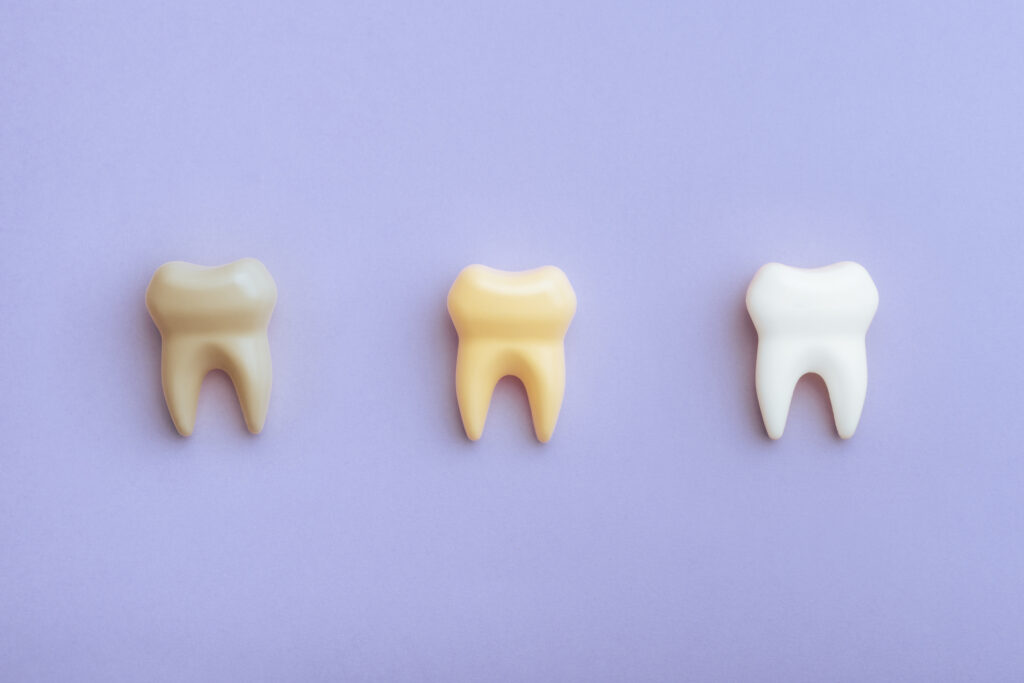
A bright, white smile is something many people strive for, but tooth discoloration can sneak up on you over time. If you’ve noticed stains or yellowing, you’re not alone. Understanding the causes of tooth staining can help you take steps to prevent it and keep your smile looking its best. At California Dental Group, we’re here to explain eight common reasons your teeth may be stained—and what you can do about it.
1. Coffee, Tea, and Wine
Dark-colored beverages like coffee, tea, and red wine contain tannins, which can stick to tooth enamel and cause stains. Even white wine, though lighter, can erode enamel, making teeth more susceptible to discoloration.
What to Do:
- Drink through a straw to minimize contact with teeth.
- Rinse your mouth with water after consuming these drinks.
- Consider switching to lighter teas or adding milk to coffee to reduce staining.
2. Tobacco Use
Smoking or chewing tobacco is one of the biggest culprits of stained teeth. Nicotine and tar create yellow or brown discoloration that can be difficult to remove with regular brushing.
What to Do:
- Quit smoking or using tobacco products.
- Brush and floss regularly to slow down staining.
- Consider professional whitening treatments to reverse discoloration.
3. Certain Foods
Foods with strong pigments, like berries, tomato sauce, curry, and soy sauce, can stain teeth over time. Acidic foods also weaken enamel, making staining easier.
What to Do:
- Eat these foods in moderation.
- Brush or rinse your mouth after eating.
- Pair stain-causing foods with crunchy vegetables like carrots or celery, which help clean teeth naturally.
4. Poor Oral Hygiene
Skipping brushing or flossing allows plaque and food particles to build up, leading to yellowing and stains.
What to Do:
- Brush twice a day with fluoride toothpaste.
- Floss daily to remove plaque between teeth.
- Use a whitening toothpaste recommended by your dentist.
5. Aging
As you age, your enamel naturally wears down, revealing the yellowish dentin beneath. This makes teeth appear dull or discolored.
What to Do:
- Maintain good oral hygiene to slow enamel wear.
- Ask your dentist about professional whitening options.
- Consider veneers if discoloration is severe.
6. Medications
Certain antibiotics (like tetracycline), antihistamines, and blood pressure medications can cause intrinsic stains, which develop from within the tooth.
What to Do:
- If you suspect your medication is staining your teeth, talk to your doctor about alternatives.
- Professional whitening treatments or cosmetic dentistry may be needed for deeper stains.
7. Fluorosis
Too much fluoride during childhood can lead to fluorosis, which causes white or brown spots on teeth. This often happens due to excessive fluoride intake from water, toothpaste, or supplements.
What to Do:
- If fluorosis is mild, whitening treatments may help.
- For more noticeable discoloration, dental bonding or veneers can improve appearance.
8. Dental Trauma
A hit to the mouth can damage a tooth’s nerve, leading to dark discoloration over time. This is common in children and athletes.
What to Do:
- Visit your dentist if a tooth changes color after an injury.
- Root canals or cosmetic treatments may be needed for severe cases.
How to Keep Your Teeth Bright
Preventing stains is easier than treating them. Follow these tips for a whiter smile:
- Brush and floss daily.
- Limit stain-causing foods and drinks.
- Avoid tobacco products.
- See your dentist regularly for cleanings and professional whitening options.
Get a Brighter Smile with California Dental Group
If you’re concerned about tooth stains, we can help! California Dental Group offers professional whitening and personalized dental care to keep your smile looking its best. Call us at 800-407-0161 to schedule an appointment today!

